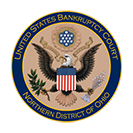Background
The creation of Portable Document Format (PDF) documents is essential for the electronic filing component of CM/ECF. It is the only format that the application accepts.
There are two primary methods for creating PDF documents: formatting text documents into PDF at the time of creation, or scanning imaged documents from paper into PDF. The formatting text method is the preferable method because it reduces labor, improves system performance, reduces storage costs, and has text-search capability.
Creating PDF Documents from a Word Processing Package
The optimal method for creating a PDF document for filing in CM/ECF is a simple method: create it directly from a word processing application using Adobe Acrobat's PDFWriter. To ensure that the formatting and appearance of the document remain the same when viewed through the word processor and when viewed or printed through the PDF reader, the printer (File/Print menu) must be set to "Acrobat PDFWriter" before beginning to compose or edit the document. If a document is initially prepared with some other printer specified, the ultimate conversion to PDF is very likely to introduce changes in pagination, fonts, spacing, or other formatting elements, requiring further proofreading and further editing. Once the document is saved as a PDF file, always print from the PDF reader (rather than from the word processor) to be sure that the printed copy matches the court's official copy.
Creating PDF Documents from a Scanning System
For those documents that must be imaged because a word-processed version does not exist, the preferred method is to scan the document directly into PDF format using Adobe Acrobat. Scanning to a format other than PDF (e.g., TIFF) would add both delay and labor, requiring not only scanning but a subsequent conversion to PDF.
There are several factors to consider when determining how the scanning will be done. The quality of the document when scanned is determined by the level of detail recorded by the scanner. This detail is referred to as the resolution, which is measured by the dots per inch (dpi). A higher resolution is slower to scan and creates a document with a larger file size. This, in turn, causes the loading of the document into the case management application and the retrieval of the document from the application to be slower. It is therefore important to find a resolution that will provide a high quality document, with a file size that does not hamper the length of time it takes to scan, load, and retrieve the document. Of those surveyed, most courts that scan recommend a resolution between 200-300 dpi.
Another factor to consider is the mode of scanning. Almost always, it should be done in black and white, so that the file size will be as small as possible. However, there are some documents (those with shaded boxes, for example) that may need grayscale instead; this, however, will produce a file that is much larger in size than the document scanned in black and white. Never create a PDF file that contains color, or scan in color unless absolutely necessary (perhaps for exhibits originally produced in color). This, too, will produce a document with an extremely large file size, which will take longer to load into the application and longer to retrieve for viewing purposes.
Additionally, do not rotate scanned document pages when creating or preparing documents for E-Orders submission. Pages that are inverted or rotated using software, so that they appear upright, interfere with order signing, and are not accepted by the E-Orders upload program.
Creating PDF Documents for CM/ECF
The requirements are outlined here.
- Format pages of the document with a one-inch margin at the beginning and end of each page.
- The page size of the document should be set to 8.5 inches wide x 11 inches high.
- Use the appropriate font(s) in your document. If your proposed order contains any font other than the font(s) listed below it will not be processed by the Bankruptcy Noticing Center (BNC).
- Arial (Regular, Bold, Italic, and Bold Italic)
- Courier (Regular, Bold, Oblique, and Bold Oblique)
- Helvetica (Regular, Bold, Oblique, and Bold Oblique)
- Times (Roman, Bold, Italic, and Bold Italic)
- Times New Roman (Regular, Bold, Italic, and Bold Italic)
- Symbol
- ZapfDingbats
The BNC also supports embedded fonts. If you are using a font that is not in the list above, then the font must be embedded in the PDF. This function is found within the Adobe PDF Settings of the PDF Print Driver.
- All comments should be removed. Security should NOT be enabled. Landscape documents are not supported by the BNC unless they have been scanned in portrait orientation. Specialty features (e.g., digital signatures, slide shows) are not supported by the BNC.
- Make sure the document is in PDF format prior to submitting it to the system. (For formatting guidelines, refer to the first page of this document.)
- Do not submit documents created using Adobe Photoshop or other photo or slide show software.
If you have any questions or concerns about the process listed above, please contact your local CM/ECF Help Desk for support.
